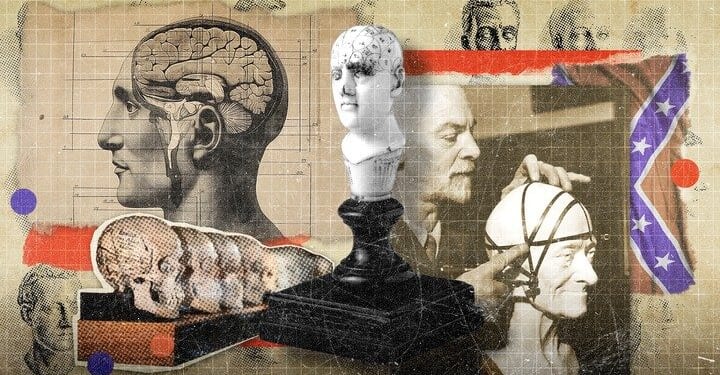C. Jay Engel is the pastor of a white-nationalist church and the promoter of a Christian-nationalist community in Tennessee (a curious change of locale for these types, who usually prefer northern Idaho). Posting under his cutesy, Tolkienesque X handle, Contramordor, Engel writes: “Heritage America is centered around the experiences and norms of Anglo Protestants. It was their customs, their instincts, their priorities, their norms, their struggle, their perspectives, that set the tone and vision of Heritage America. Anything outside of that either was either assimilated or was killed off.”
Engel allows Italian-Americans and Greek-Americans and other lesser breeds into the Heritage America tent, notwithstanding that it “was a significant sociopolitical mistake” to admit “the type of people that came here during the Ellis Island generation.” The likes of Andrew Cuomo, it seems, will be tolerated — but only if they “are ethno-culturally tied to the ethos and spirit of the United States prior to its definitional transformation into a Propositional Nation after World War II.” (Maybe there should be a lustration process, in which swarthy Ellis Island Americans ritually denounce Emma Lazarus’s poem “The New Colossus,” inscribed on the Statue of Liberty.)
According to Engel, Heritage America “includes the blacks of the Old South (like Booker T. Washington), though it repudiates any instinct that some of them have to leverage their experience for the purposes of political guilt in our time. It also includes integrated Native Americans with the same stipulation.” Ah, there are stipulations. So black and Native-American membership in Heritage America is conditional on their agreeing with Engel’s ideology — otherwise, no Heritage for them. Meanwhile, “peoples like Indians, or Southeast Asians, or Ecuadorians or immigrated [sic] Africans are the least capable of fitting in and should be sent home immediately.” Under the New Order, then, Vice President JD Vance will have to visit his Indian-American wife and mixed-race children in South Asia.
All of this turn my thoughts turn to an important question: Am I a Heritage American?
My earliest ancestor in the New World, according to family tradition, was a Scottish pirate who practiced his trade in the Chesapeake Bay in the early 17th century, following the founding of Jamestown. In 1648, another ancestor, Thomas Lane, was one of 47 people “transported” from England to labor on the plantation of a gentleman who had been granted 2,350 acres in Virginia that had been carved out of “Indian lands” only three years earlier in 1648. His descendant William Lane Sr. became a wealthy slaveowner in Fairfax County and a captain in the Virginia militia during the American Revolution.
One Tennessean ancestor of mine fought at the Battle of New Orleans under Andrew Jackson and died of a disease contracted in camp. Another had his farm in Georgia burned by Union forces during Sherman’s march in the Civil War. Still another ancestor, a member of the US Cavalry, was shot while fighting Indians on the western plains during the Civil War; he survived and came to central Texas as part of the federal Reconstruction forces. The family heirlooms I own include a small arsenal: a stiletto dagger; two flintlock pistols and a powder horn; a vintage Colt Walker revolver; some Civil War minnie balls and a grenade; the sword given by the Army to my great-grandfather, who served in the Spanish-American War.
Last but not least, after the Civil War, my great-great-great grandfather, a Texas cowboy, proposed to his bride by handing her a letter from horseback before he rode off to join a cattle drive. And a distant relative of mine in a collateral line was Wyatt Earp, the legendary lawman of O.K. Corral gunfight fame. Sounds pretty Heritage-y to me.
But those are all maternal ancestors. On my father’s side, I am a third-generation Swedish-American, and according to Pastor Joel Webbon, another white-nationalist firebrand with growing influence these days, “first-generation immigrants can never be true Americans. But neither can [the] second generation, even if born and raised here.”
He has a point. It takes diasporas a while to dissolve, if they are not replenished. My Swedish-born great-grandmother would ask her children, when they brought home friends from the one-room prairie schoolhouse, “Ar de svenskar eller Amerikaner?” (“Are they Swedes or Americans?”)
Then again, the immigrant Swedish-American pioneers and their children were white and Protestant, and they cleared land for small family farms. One of my ancestors on the Swedish side worked as a cowboy on a cattle ranch. Heritage or Hyphenates?
To complicate matters further, I am also one-eighth Jewish (the Union cavalryman shot by the American Indian during the Civil War was an Austrian-Jewish immigrant). Can Jews be Heritage Americans? According to Pastor Webbon, America is “not for Hindus. It’s not for Muslims. And it’s not for Jews. It belongs to Christians.” Non-Christians “can be in the car … but they don’t get to drive.” Now I’m worried that my driver’s license will be revoked in the Heritage American Regime.
“I don’t know whether I am a simple white, a non-Hispanic white, a MENA, a Jew, a second-degree Mischling, or a Heritage American.”
My identity crisis deepens. To be fair, I have been confused about my racial identity for most of my life. According to the US Census, I was born a simple “white.” But then, in the 1970s, the federal government resolved that I’m a “non-Hispanic white,” a term made up by the Census in those years as a catch-all encompassing every white ethnic group that doesn’t know how to make good tamales. Under the Biden administration, the Census added a new category, “Middle Eastern and North African,” or MENA, that includes many ethnically Jewish people (in addition to Persians, Gulf Arabs, Levantines and Mesopotamians, and Amazighs, among others). Am I still a non-Hispanic white, or, as a one-eighth Jew, am I a MENA?
Confusing matters further, under halachic law, I am Jewish because my mother’s mother’s mother was Jewish. And yet under the Nazi Nuremberg Laws, I would have been classified as a non-Jewish Mischling of the second degree, rather than a Jew.
Bottom line: I don’t know whether I am a simple white, a non-Hispanic white, a MENA, a Jew, a second-degree Mischling, or a Heritage American.
Let’s turn from biological race to American culture. According to Ben R. Crenshaw, a doctoral student at Hillsdale College and another race-Right theorist: “Liberalism only ‘worked’ in America because these [white British Protestant] identities were commonly known and accepted… Thus, if America hopes to regain her strength, to preserve her historic people and way of life, and not be plundered of her wealth and inheritance by international pirates, then she must recover her own identity politics. She must ask and answer with force and conviction what her identity is. And then, she must have the political will to once again practice a politics of exclusion and preservation if she hopes to remain America much longer.”
Who knew that everything good in this country was done by my old-stock ancestors before all those non-British Europeans at Ellis Island and recent immigrants from elsewhere in the world arrived and screwed everything up? Is there a club I can join, like Sons of Heritage America? A secret handshake? Discounts on Heritage Americana on sale at the local Cracker Barrel?
I have to confess that I like the idea that, if I qualify as a Heritage American, citizens of other ancestries should ritually offer their thanks to my progenitors. It would be nice if, when I am on an airplane, the pilot would announce: “We have a Heritage American on the flight today, please give him a round of applause.” And I would smile benignly as strangers shook my hand, saying, “Thank you for the service of your British Protestant ancestors.”
To be honest, though, I’m not convinced my British ancestors really deserve to be retroactively thanked for taking part in a heroic, visionary effort to found a new society. Most of them just wanted to buy land and maybe slaves and make money. Many of my colonial-era English ancestors in the 1600s seem to have been indentured servants, brought over as contract laborers to work for fixed terms for this or that Southern tobacco farmer with a headright granted by the Crown, before obtaining their freedom.
As for the Scots-Irish in my family tree, they didn’t cross the Atlantic from Northern Ireland in the 1700s because they had a bold spirit of adventure and wanted to wrassle bears, wear coonskin caps, make moonshine, and invent NASCAR. They were victims of rising rents charged by English landlords who gentrified Ulster, after having used the Scots-Irish as their shock troops in subjugating and ethnically cleansing the Catholic Irish.
As far as I know, neither my English nor my Scots-Irish ancestors before 1776 had any intention of creating a nation-state organized as a democratic republic that would be independent of the British Empire and a beacon of liberty to the world. Only a few zealous Puritans in New England had grand visions of the American future, hoping that the saints of New England would launch the conversion of humanity to Calvinism — not liberal democracy.
To be fair, pan-racial categories like non-Hispanic white and “MENA” and Asian and Pacific Islander are just as absurd as the idea of a pan-white, pan-Christian, or pan-Protestant Heritage American. The political scientist Eric Kaufmann has observed that the US system since the 1970s has been one of “asymmetric multiculturalism” — pan-racial categories get to have their own official “cultures” and “traditions” and “symbols,” but that is not allowed for whites — sorry, non-Hispanic whites.
Forget, for a moment, domineering white Christian nationalism. Why not allow symmetrical multiculturalism, in which the color white is added to the rainbow in a non-aggressive way? Why not White Pride Week and White Heritage Month and a White History Museum on the national mall, where tourists can learn about the many contributions to our country of white Americans like George Washington and Thomas Edison and Lady Gaga?
The problem is that many stereotypically “white” cultural traditions are not, in fact, white in their origins. For centuries, despite division along the lines of racial castes, American culture has been a mixed-race melting-pot culture. The archetypical corn-fed Midwestern farm boy was fed on maize, developed originally in Mesoamerica by Native Americans. Barbecue? From barbacoa, a loan word in Spanish from the Taino Indians of the Caribbean for a meat smoker.
The American cowboy is a version of the Mexican vaquero, from his lariat (la reata) to his chaps (chaparreras) to his boots. In the 1950s and ’60s, a majority of American suburban houses were ranch-style homes, popularized by Cliff May, whose one-story designs with patios (another Spanish word) were inspired by the homes of his Spanish and Mexican ancestors in California. The banjo? An African instrument, brought to the New World by slaves and popularized among whites by 19th-century minstrel shows.
“The archetypical corn-fed Midwestern farm boy was fed on maize, developed originally in Mesoamerica by native Americans.”
If you throw out everything in white American culture except colonial-era British Protestant imports, you’re left with — what, exactly? Boston baked beans? Buckled shoes? So maybe we should think twice before inventing Kwanzaa for white people.
Like pan-racial “cultures,” pan-racial political solidarity of any kind is rare in the United States. The slowly eroding bloc voting of black Americans is the exception to the rule. Though tilting toward Democrats, Hispanics and Asian-Americans have long divided their votes between the two parties. So have so-called Heritage Americans.
The Patriot and Loyalist factions in the Anglo-Protestant majority fought each in the Revolutionary War. A few generations later, Northern Anglo-Protestants and Southern Anglo-Protestants fought in the Civil War, which killed more Americans — mostly white Protestant Americans — than all other US conflicts combined.
Plus, white Americans have always been found in rival parties. In the 2024 election, white voters, who made up 71% of the electorate, were pretty evenly split, with 57% voting for Trump and 42% voting for Harris. To the perpetual dismay of white nationalists, the political divisions among white Americans — regional, religious, cultural, class-based — have always defeated any pan-white consciousness, even in the most racist eras in American history. Though a few of its members may infiltrate the Republican Party now and then, the fringe Right will remain on the fringe because there is no chance that normal, sane white Americans will ever be persuaded that they must set aside their other differences and unite in politics against domestic racial and religious minorities and nonwhite and non-Christian immigrants.
Darryl Cooper, the online autodidact who provoked outrage when Tucker Carlson let him spread his revisionist views about Nazi mass murder, made this obvious point in a podcast with the nativist writer Scott Greer: “Most of the Southern racialists I know are closer to neo-Confederates than white nationalists, and don’t labor under the illusion that they share much of a common destiny, let alone a common identity, with Portland hipsters or Upper East Side Jews, or even liberal Yankee elites, for that matter.”
Given the many divisions among Heritage Americans, the United States isn’t going to become a white Protestant ethno-state any time soon — certainly not under President Trump, with his Jewish in-laws and Jewish-convert daughter. Indeed, the only way in which the GOP can hope to obtain a sustainable political majority is to build upon the gains made by Trump in the 2024 election among working-class Hispanic and black voters.
Contra the Heritage Americans, the racial divide is weakening in US politics and giving way to the “diploma divide” among all races. Nothing could undercut the growth of the Republican coalition more than toleration by mainstream Republicans and conservatives of fringe white nationalists, who have podcasts and fly-by-night churches and rural compounds, but no significant number of voters behind them. To quote Tennessee lawmaker and frontiersman David Crockett, a Heritage American if ever there was one: “That don’t make sense. It don’t even make good nonsense.”
















